| The name Cacti or Cactus has been adopted by the masses as the universal term to describe succulent plants. I have heard the term used to describe a varied range of plants from Euphorbias to Fouquierias (Ocotillo) to Agaves, Yuccas, & Aloes. By including what are not cacti, CactiGuide.com can be a more useful guide through the process of elimination. The table below lists examples of other succulents that resemble cacti but are not. This should give beginners a good start. There are exceptions to every rule and this is so true with the features used to identify cacti. Those who happen across such an exception should prepare to do some extensive research and be patient. Some of the features that separate cacti from other genera are:
Growing and propagating cacti is relatively easy to do and can be quite
rewarding. For the most part there are three environmental variables to
consider to ensure your experience with growing cacti is successful. These are:
We'll examine these three conditions in
greater detail shortly, but first let's note that there are at least two
different groups of cacti. There are the desert cacti which is
certainly the first type to come to mind whenever someone hears the word
"cactus". However, there are also jungle cacti which
grow in rain forests and other environments that most would consider the least
likely habitat for a cactus plant. I'll address growing conditions for the two separately
beginning with the jungle cacti.
Jungle Cacti Jungle cacti include those species in genera such as Acanthocereus, Disocactus,Epiphyllum, Hatiora, Hylocereus, Lepismium, Rhipsalis, Schlumbergera,Selenicereus, and perhaps a few others. Almost everyone has seen at least one representative from this group even if they were unaware that the plant was actually a cactus. The most common of these are the holiday cacti, Easter Cactus- Hatiora gaertneri, Thanksgiving Cactus- Schlumbergera truncata and Christmas Cactus- Schlumbergera x buckleyi. These plants are all true cacti despite their lack of big spines and inability to withstand the harsh conditions of the desert. Now when we associate "cactus" with one of these, it does not seem unusual that they would require different care when growing than the stereotypical image that comes to mind when we think about the family cactaceae. Soil Most Jungle cacti are either epiphytic or lithophytic meaning they grow in trees or grow on rocks respectively. This type of plant gets its nutrients from the air or from dead leaves and other debris that may have collected in crotches, cracks, or crevasses. It is important to note that there are no parasitic cacti. Those that grow in trees do so for support, but do not sap nutrients from their host. For best results we'll want our soil to mimic these natural conditions. Some good ingredients for creating a suitable potting mixture for Jungle Cacti include: orchid bark, pearlite, potting soil, peat, coir, pumice, and oak leaf mold. I haven't tried all of these, but have found a mix that works really well for my plants. I start with some coarse orchid bark (about 25%), mix in some potting soil (25%), peat (25%), and the rest mostly pearlite with maybe 5% coarse gravel. I've heard enough people suggest that coir is a superior substitute for peat and have recently experimented with it, but have not used it long enough to tell if it actually works better. The most important aspect of the mixture is good drainage. The pearlite helps create this by keeping the soil loose and "airy" and so does the orchid bark. Additionally the orchid bark tends to hold more moisture than pearlite or gravel. Pumice can be substituted for the pearlite. Keep in mind that the orchid bark will eventually break down into soil. This will create a very rich soil that may not be as effective in keeping the roots healthy. It isn't a bad idea to re-pot these plants every 2 or three years with a fresh mix. The best time to do this is shortly after your plant has finished blooming. This is when it will be ready to start growing again. You might also add some fertilizer to the new mix such as bone-meal and/or Osmocote. For more information on creating a soil mix see this article. Water It is no accident that I've listed water as the second item on the list. This is because a well drained soil is critical for keeping the water from rotting the roots off the plant. With the proper soil, however, watering is really quite simple. I water my Jungle Cacti about once a week. This is a good rule of thumb, but there are exceptions. During extended hot, dry periods I may water twice in one week. Conversely, when it is cool and rainy I might switch to every other week. I grow all my cacti outdoors which is a privilege afforded by my Southern California location. Indoor plants should have less variation in watering needs. For those living in colder regions, you may find that you have to water your indoor Jungle Cactus more in the winter than in the summer due to the dryer air from running the heater. The easiest way to gauge whether or not it's time to water is to stick your finger in the top 1/2 inch of soil. If the soil is dry, go ahead and water. If it's not, wait! Don't let your Jungle Cactus go too long without water. If the stem segments are shriveled and the soil is dry, it is probably in need of water. Be careful! If the plant is over watered, the stems will also look shriveled, but the soil will be damp. If this is the case, do not give it more water. An over-watered plant will start to turn yellowish, then get more and more mushy and dark reddish-brown like a rotten apple. This is because the cells took in so much water they broke and are now dead and rotting. This usually happens from the ends first. This will continue even after you stop watering too much, but often you will have enough plant left to start over. Light Jungle Cacti can survive in a wide range of light conditions. However, we'll assume the goal is not to have plants simply surviving, but thriving. For the plants to thrive the amount and intensity of light are key ingredients. In my experience the ideal condition for Jungle Cacti is full morning sun and then shade for the afternoon. All the plants I have in this ideal condition exhibit robust and healthy growth. There are three other lighting situations that are not as ideal, but often times necessary due to space constraints. These are morning shade/full afternoon sun, full shade, and full sun. Let's explore these conditions further. It may seem that shade in the morning and full-sun in the afternoon should produce the same results as full morning sun/afternoon shade, but it doesn't. This is because the temperature is cooler in the morning than the afternoon and for many plants the afternoon sun is a little too intense and plants will often take on a sickly-yellow appearance and may develop spots. In full-sun these symptoms will be even more apparent. As with most things in nature there are exceptions and some plants actually prefer full-sun and thrive in it. In full shade the plants will don a dark-green healthy appearance, but the stems will be stretched out long and thin in an attempt to reach more light. Not only is light essential for healthy stems, it also triggers blooming in many species. In ideal conditions a particular plant may exhibit fantastic growth with many show-quality stems, but they won't bloom. In this situation exposing the plant to longer and more intense sunlight will trigger it to bloom. Don't forget that plants can get sunburn just like people do. If you have a plant that has been mostly shaded, don't just stick it out in direct sunlight or you will certainly end up with a badly scared cactus. This is even true for desert cacti that occur naturally in extremely hot, intense sunlight. Desert Cacti Desert cacti hail from throughout the arid regions of the America's and surrounding islands. There are no desert cacti native to the old world and only one jungle species that occurs in Madagascar. Despite this, many people envision cacti growing in pure Sahara Desert sands with practically no water. This common mis-perception should not be in your mind when you are preparing an environment for your desert cacti. We'll explore the requirements for growing healthy desert cacti shortly. First let's summarize the different types of desert cacti you may encounter. There are small rounded, flat, or cylindrical plants; there are shrubby, segmented, and sprawling kind; and there are the large columnar and tree-like giants. Although even within each of these groups growing conditions vary from one plant to another, I'll generalize as much as possible for a successful all around growing environment. Soil The perception I mentioned earlier of cacti growing in pure sand is not held by any successful cacti grower. Most cacti prefer a nutrient rich, rocky soil with good drainage. To create a suitable growing median for our desert cacti we'll use some of the same ingredients that we used for jungle cacti as well as some new ones. These are pearlite, pumice, potting soil, rocks, sand, peat, coir, and gravel. After trial and error and advice from other growers, I have settled on an easy, well-draining mix. This mix consists of 60% pumice, 20% coir, 20% Supersoil (topsoil). The pumice can be replaced with pearlite or vermiculite and the coir replaced with peat. I would recommend using only 10% peat, not 20% if you don't use coir and make up the difference with more supersoil, pumice, or even sand. This is because peat tends to be rather hard to re-wet and can make your mix impenetrable to water. For larger pots or mixes directly in the ground I like to add 1 to 2 inch lava rocks from anywhere between 5 and 10 percent. I've had great success with this, but it can make digging or transplanting more difficult because you'll hit rocks with your trowel or shovel. Some people use earthworm castings for extra nutrients. I've always mixed in some Osmocote time-release fertilizer and have also mixed bone-meal in some of the time. Remember, there is no one mix that is the perfect mix. Ultimately, you'll want to experiment with different ingredients until you find one that works for you. Just remember that cacti roots need a well-draining, airy soil that will re-wets easily. Use whatever materials are most readily available to you locally. A simple observation to determine if your mix is cacti-suitable can be made each time you water. The water should not sit on top of the surface and eventually drain down through the mix. Instead the water should very quickly soak down through the pot and out the drain holes at the bottom. Always make sure that your pots have good drainage holes and that no water is able to sit in the bottom of the pot. For more information on creating a soil mix see this article. Water Their ability to survive in extremely hot, arid, harsh habitat is a truly fantastic attribute of cacti. However the notion that cacti do not need water or that they actually must avoid water in order to survive is unquestionably false. The reality is water is essential for all cacti to live. Their reputation comes from their ability to survive in areas where water is available in small amounts or is delivered infrequently. Most desert cacti can sustain long periods of drought. This is because the last time water was available to them, they stored as much as possible in their tissues. Additionally cacti contain many features that enable them to keep that moisture and not dry up in the heat of their environment. Desert cacti are made to thrive in their native environment, which is most likely not anything like the environment where you'll be growing them. Even so, when it comes to watering cacti, there is no reason to artificially create drought. Whether potted or in the ground, a good time to water desert cacti is whenever the soil is dry. In hot, dry areas such as Souther California in summer, watering once a week is acceptable. In more humid or cooler areas, it may be three to four weeks before the soil dries enough to warrant more water. The key then isn't to avoid watering, but rather just don't over-water. With that said, it is still better to under-water than to over-water. Avoid watering if the soil is still moist. There are exceptions to every rule and just like choosing the right soil, you'll need to experiment to find the best watering regime for your plants. Light Unlike the jungle cacti, desert cacti typically prefer a lot more light. My desert cacti, which are planted right in the ground, get full sun all day long and love it. My potted plants, seedlings, and newly rooted cuttings only get sun for half a day. The sun would make short work of plants that are not established. Therefore it is not wise to move cacti into the full sun until they have a healthy root-system. Even if potted plants are established, full sun should be avoided. This is because the sun will heat the roots in pots to temperatures much higher than roots in the ground. This is not a natural condition and the roots are not made to survive high temperatures so make sure your potted plants don't get too hot. One way to prevent this is by using white pots instead of black. If you are growing your potted plants indoors, it will be highly unlikely that you'll find a spot where your cactus gets too much light. If anything, the opposite will be true. In the case of limited natural light, full-spectrum fluorescent lights can be used to supplement or replace sunlight. You can get approximately 24 square feet of growing space under four 74-watt tubes for a cost that is under fifty dollars. It will be easy to tell if your cacti need more light. Cacti that are not getting enough light will exhibit thin, stretched-out growth. If you are unsure what normal growth is supposed to look like, look for pictures of your plant on CactiGuide.com or other sources. Conclusion Growing cacti can be a lot of fun and doesn't require tremendous effort. Creating the growing environment that works best for you will likely require some trial and error. Once you establish the best soil, water, and light mix for your location the cacti will do the rest. Cacti come in a diverse range of unique and/or unusual growth forms. I have gotten a lot of enjoyment out of both growing cacti and building CactiGuide.com. I hope that this information helps others likewise find enjoyment in the hobby. Geographic Distribution & Habitats of the Cactus Family Introduction The natural distribution of cactus species occurs exclusively in the New World with a single exception. This range includes North and South America, Central America, and the adjacent Islands such as the Caribbean and Galapagos islands. Rhipsalis baccifera, an epiphytic species is the sole exception that can be found in Madagascar, Tropical Africa, Seychelles, Mauritius, Reunion, and Sri Lanka as well as Tropical America. Note: To view cacti by location, use the CactiGuide.com Geographic Distribution Search. Latitude 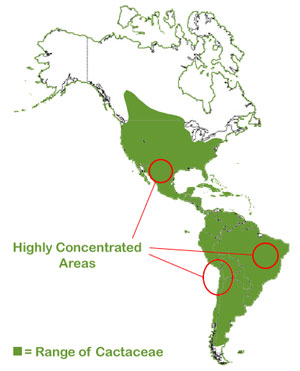 Within the Americas, some species of cacti are found at latitudes that many find surprising. To the North, cacti are found across southern Canada from Ontario to the East to British Columbia in the West. In the drier, milder western range, cacti can be found further north than in the east. Only a half-dozen or so hardy species are able to survive this climate and those that do are low-growing, fairly inconspicuous plants. To the extreme Southern tip of South America, one also finds the low-growing Maiheniopsis darwinii, Maihuenia patagonica, and Pterocactus australis. Within the Americas, some species of cacti are found at latitudes that many find surprising. To the North, cacti are found across southern Canada from Ontario to the East to British Columbia in the West. In the drier, milder western range, cacti can be found further north than in the east. Only a half-dozen or so hardy species are able to survive this climate and those that do are low-growing, fairly inconspicuous plants. To the extreme Southern tip of South America, one also finds the low-growing Maiheniopsis darwinii, Maihuenia patagonica, and Pterocactus australis.The larger, barrel-shaped, columnar, and Tree-like plants that are the stereotypical representatives of the family are mostly confined with in the tropics, extending somewhat north of the Tropic of Cancer into the Southwestern United States and pushing south of the Tropic of Capricorn into Northern Argentina. Altitude Cactus plants are found at sea-level growing down along the coast of both the Atlantic and the Pacific oceans as well as low-altitude inland areas such as Death Valley California. In North America, cactus can be found growing up to at least 11,000 feet (3350 meters) in the mountains of California; particularly the White Mountains, and possibly even higher in some areas of the Sierra Nevada range. In South America on the Western edge of the Andes mountains, cacti grow even higher at 15,000 feet (4500 meters) elevation. As would be expected, the high altitude plants are also low growing plants similar to those at the far northern and far southern latitudes. Additionally, high-altitude plants are often particularly spiny or wooly to help shield from the high UV due to the thinner atmosphere. Examples of this are Opuntia polyacantha var. erinacea and Austrocylindropuntia floccosa. 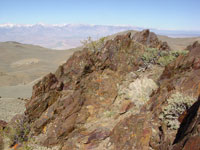 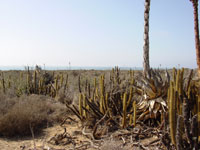 Left: Opuntia at 11,000ft, White Moutains, CA Right: Bergerocactus at Sea Level, Baja California, Mexico Climate While "Desert" is the always the first thing that comes to mind when someone thinks of cactus habitat, this term is far too broad and too limiting in comparison to the actual localities where cacti occur. To start with, the Sonora Desert of Arizona and Northern Mexico is extremely lush in comparison to the Mojave desert to the west. In the Sonoran, desert many species of cacti can be found from the giant Saguaro to small Mammillaria species along with Ferocatus, and many Opuntiads all within only a few feet of each other and in association with other desert plants like Palo Verde. The density and overall larger size of plants here is due in most part to summer monsoons which bring rain up from the Gulf of Mexico in addition to the winter rains. Meanwhile the Mojave desert in California experiences only winter rain while it is hot and dry the rest of the year. As a result, cactus plants are smaller and more spread out as they compete for the limited moisture. 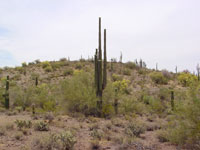 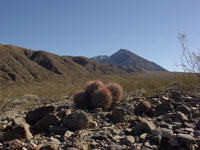 Left: The Sonoran Desert grows large cactus due to summer rains Right: The Mojave Desert is stark by comparisson. Other deserts in North America include the Great Basin, and Chihuahuan. Both of these have more limited moisture than the Sonoran, but also have colder temperatures due to elevation and weather patterns. This again limits the dispersion and sustainable size of the cactus that live within each area. All of the deserts of North America are "mild" in comparison to the deserts of Western South America. The Atacama desert in Chile is the driest place on earth. Here it may only rain once in 10 years. In some areas, there has been no rainfall at all in recorded history. Yet, cacti survive here due to a dense and heavy fog that condenses on plants and rocks and drips down into the soil. Plants are forced to give each other a wide berth because of the low moisture, but surprisingly they can become relatively large plants. Larger than any found in the wetter, but cooler deserts such as the Great Basin Desert. 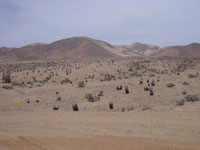 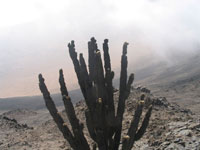 Left: Copiapoa in the harsh Atacama Desert Right: Eulychnia in Peru and life-giving fog in the background. As stated above, "desert" is a term too limiting for cactus habitat. Cacti can be found also in the grassland regions of both continents. Here they often grow on rock outcroppings where soil is thin or areas where the soil is especially gravely causing other plants and grasses to be dwarfed or sparse. Cacti survive in these areas because of their succulent stems and ability to retain water. While the plains areas do receive plenty of rainfall, the rocky soils drain and dry out quickly. As a result, the more aggressive grasses cannot choke out the cactus. 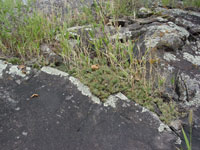 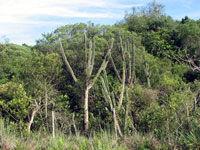 Left: Opuntia on granite outcropping in Minnesota Right: Cereus growing among grass and shurbs in Brazil The least likely seeming occurrence of cactus is within tropical rain-forests and jungles. Few people realize that cactus grow where it rains almost every day of the year. However, these species are very different from the spiny barrels we find in the desert. In the jungle, cacti are epiphytes, meaning they live hanging in trees. Here cacti take on a thin, long, drooping habit. They put out roots to cling to the tree and take in what ever nutrients they can get out of the crevices where rotting leaves may have accumulated. The most familiar example of an epiphytic cactus is the "Christmas Cactus". While the true Christmas cactus is a hybrid, the parents of this come from epiphytic jungle growing species. Conclusion This overview touches on some of the general environments where cacti occur. Within each, there exists more specific micro-climates and conditions which host species uniquely suited for those conditions. Readers may find that the native range of cacti is more restricted than they previously thought in terms of world-wide distribution. On the other hand, the occurrence of cacti in very wet and/or very cold environments may also be a surprise to many. | ||||||||||||||||||||||||||||||
Cacti
Subscribe to:
Comments (Atom)










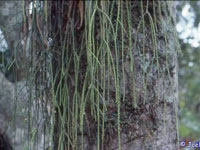
No comments:
Post a Comment